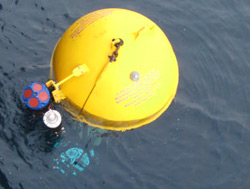In the Irminger Sea by Dallas Murphy
Current position: 65 degrees, 05 minutes North by It was rough last night, when most of us aboard would have been happy with a more gentle start. The wind was blowing about 35 knots from the north, and the ship was heading west. That means that the waves were hitting the right—the starboard side—of the ship, and so she rolled something fierce. Anything not tied down crashed and jumped around. The quality of life aboard a ship at sea is determined by wind, which causes waves, which in turn determines the motion aboard. One of the remarkable things, among many in these latitudes, is that fulmars, a gull-like bird, follow the ship constantly in all weather. They swoop and glide as if having fun, while humans in our high-tech wicking wear and puffy coats stagger around the deck as if walking were a new skill. Sometimes one feels jealous of the birds in their perfect adaptations to life at sea. A little further north, we’ll begin to see kittiwakes, sweet little robin-sized birds that skim expertly a few inches above the waves. I’m not sure why fulmars and kittiwakes follow ships up here in the north. Perhaps they’ve learned to follow fishing boats, but they never give up hope. WHY MEASURE THE OCEAN? Now let’s talk a little about what we’re doing out here, beginning with why we try to understand the movement of the ocean. First, we have to grasp the fact that the ocean—all oceans—move all the time in small ways and large. The most obvious movement is waves caused by wind. And then there is the apparent in-and-out, up-and-down movement of tides, caused by the gravitational pull of the Sun and Moon (mostly the Moon, because it’s closer to us than the Sun). But there is another kind of ocean movement that cannot be easily observed from land. We’re talking here about currents. Let’s define a current as a large mass of sea water of a similar kind that moves consistently in a single direction. These currents have a technical name that sounds like a description: they’re called “ocean currents.” Probably the most famous of these is the Gulf Stream, but there are many others. Every ocean in the world contains a system of ocean currents. They have individual names, but ocean currents don’t come to an end as rivers do when they reach the sea. Each is connected to the other within the system. And the system in one ocean is linked to the current systems in the other oceans. Some currents flow on the surface and some move through the deepest parts of the ocean miles below the surface. Some are warm, and some are cold; some are narrow and fast, some slow and wide. Some flow north, others south, and still others east and west. We can think of them as giant blood vessels coursing through the water linking all oceans of the world into one single ocean. Blood vessels circulate through our bodies linking all our parts on the inside and outside into what we call “us.” As our trip goes on, we’ll have much more to say about currents, how they influence our climate, and why, therefore, they matter in our lives—even to those of us who live hundreds of miles from salt water— Oh, dear. I just heard through the grapevine that the weather is going to turn really nasty by evening time (Sunday). This whopping great storm is bearing down on us from the west. I don’t like the sound of it: 50 knots of wind and waves 10 meters high, about 30 feet. Gulp. But that’s how it goes in these Arctic waters. There’s nowhere to hide, no land within 90 miles, so we’ll just have to take our beating. Knorr is a stout steel ship, 280-feet long, but she’ll be feeling very small by midnight, and some of us won’t be so happy. That’s an interesting part of this oceanography business. We have all this high-tech equipment, brilliant scientists, an expert crew and officers, all the best modern navigation gear—but we’re not so different from the mariners of 100 years ago. The way of the sea still rules our lives. I’ll talk with you tomorrow assuming my seasick medicine works. Wish us luck, bye for now. Ulloq arfininngorneq by Nick MøllerUllumikkut ulloq atoruminarpoq malissiornata kivisittakkat sisamat qaqippagut, piffinni assigiinngitsuni inissisimasut. Taaneqareersutuut kivisittakkat aaliangersimasumi itissutsimi inissitaapput, angisuujupput arsatut angisuutut isikkoqarlutik, sungaatumillu qalipaateqarlutik. Piffimmut aaliangersimasumut pigaangatta atortorissaarut imaanut aqqartinneqartarpoq, taannalu atorlugu attavigineqartarlutik. Atortorissaarummik attavigineqarnerasigut kiisartoq kiversartakkamut najummisoq kaanngartinneqartarpoq, taamaasillunilu arsaasarsuaq puttallartinneqartarluni. Arsaasarsuarmi ipput atortorissaarutit ukioq kaajallallugu nalunaarsuisut, immap kissassusianik, sinaannaqassusianik taamatullu tarajoqassusianik paasissustissanik toqqortuiffiullutik. Kivisimatitsissutiginearpoq kisaq, taannalu immap naqqanut qimaanneqartarpoq, pingaarnerpaavormi atortorissaarutip ukioq kaajallallugu paasissutissat katersarisaai qaqinnissaanut. Arsaasarsuit sattelitsit atorlugu (GPS) sumiissusersineqartarput taamaasillutalu piffissaq sivisunngitsoq atorlugu arsaasarsuit sumiissusersisarlutigit, arsaasarsuit katillugit arfineq pingasuusut, siulliit sisamat ullumikkut qaqippagut, pilersaarutaallunilu aqagu sinneri qaqinneqarnissaanut. Arsaasarsuit qaqinneqareeraangata sumiiffigisimasaanut umiarsuaq inissittarpoq CTD - lu atorlugu imartaq misissorneqartarpoq. CTD tassavoq kivisittagaq immaq tarajoqassusianik, kissassusianik qanorlu silaannartaqartigineranik misissuut eqqorluinnartumik nalunaarsuisartoq. Taamatuttaarlu piffinni arsaasarsuit nalunaarsuiffigisimasaanni immaq uumasuaraqassusaanik misissuut kivisinneqartarpoq, taannalu atorlugu immap uumasuarai sorlerpiaat misissuvigineartarluni. Imaanimi uumasuaqqat assigiinngitsut amerlalluinnartuupput, apeqqutaalluni sumiiffik immallu qanoq najoruminartiginera uumasuusarlutik, taakkuuppummi immap uumasuarai imaani uumassusilinnik pingaaruteqarluinnartut. Uumasuaqqat allaallumi aalisakkat, puisit arferillu imartaq najussallugu orniginerusarpaat sinaannartaqarluartoq aammalu tarajoqarluartoq. Silaannaap allanngoriartupiloorneranik kalaallit nunaanni sermersuaq aattornera annertusiartortillugu, tamannalu malitsigalugu sermeq aattoq immamut apuuffeqartarluni, tamanna immap tarajoqassusianut sunniuteqartarpoq, tarajoqarneranut sunniuteaaraanga assigalugu aamma immap uumasuinut suugaluartunulluunniit sunniuteqartarluni. Taamaattumik pingaaruteqarpoq kalaallit nunatta imartaa, silaannaap kissakkiartorneranut qanoq sunniutearnersoq milinnaavigissallugu. Takorlooruminaappormi siunissami nunarsuatsinni sinaannaap kissakkiartornera ullumikkutut ingerlaannassappat, siunissami imartaq qanoq isikkoqarumaarnersoq. Last updated: October 17, 2008 | |||||||||||||||||||
Copyright ©2007 Woods Hole Oceanographic Institution, All Rights Reserved, Privacy Policy. | |||||||||||||||||||

